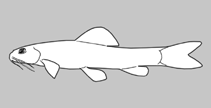Paraschistura abdolii Freyhof, Sayyadzadeh, Esmaeili & Geiger, 2015
Envoyez vos Photos et vidéos
Images GoogleNo image available for this species;
drawing shows typical species in Nemacheilidae.
Images GoogleNo image available for this species;
drawing shows typical species in Nemacheilidae.
Classification / Names Noms communs | Synonymes | Catalog of Fishes(Genre, Espèce) | ITIS | CoL | WoRMS | Cloffa
> Cypriniformes (Carps) > Nemacheilidae (Brook loaches)
Etymology: Paraschistura: Generic name taken from its similarity with the genus Schistura; abdolii: Named after Ashgar Abdoli, an Iranian fish ecologist who collected this species together with J. Freyhof in 2007. A noun in genitive, indeclinable.
Eponymy: Dr Asghar Abdoli is an Iranian fish ecologist who collected this species together with Jörg Freyhof (2007). [...] (Ref. 128868), visit book page.
Etymology: Paraschistura: Generic name taken from its similarity with the genus Schistura; abdolii: Named after Ashgar Abdoli, an Iranian fish ecologist who collected this species together with J. Freyhof in 2007. A noun in genitive, indeclinable.
Eponymy: Dr Asghar Abdoli is an Iranian fish ecologist who collected this species together with Jörg Freyhof (2007). [...] (Ref. 128868), visit book page.
Environment: milieu / climate zone / depth range / distribution range Écologie
; eau douce démersal. Subtropical
Distribution Pays | Zones FAO | Écosystèmes | Occurrences | Point map | Introductions | Faunafri
Asia: three drainage basins in southern Iran: Kol drainage, Sirjan basin and western tributaries of the Hamun-e Jaz Murian basin.
Taille / Poids / Âge
Description synthétique Clés d'identification | Morphologie | Morphométrie
Paraschistura abdolii is distinguished from its congeners in Iran by a combination of following non-unique characters: deeply embedded and often isolated scales on the caudal peduncle and, in some populations, present immediately in front of the dorsal-fin origin (vs. body scaleless in P. turcmenica and P. kessleri) and a color pattern of 11-19 regularly or irregularly shaped pale- or dark-brown bars, often dissociated into a marmorate pattern (vs. 10-12 distinct, regularly shaped and set dark-brown bars in P. kessleri); absence of scales on the back, or scales on the back present only in front of the dorsal-fin origin (vs. back fully covered by scales in P. bampurensis and P. nielseni) and by the absence of a suborbital flap or groove in males (vs. suborbital flap present in P. bampurensis, suborbital groove present in P. nielseni); very slender body (vs. stout in P. nielseni); absence of a dorsal adipose keel (vs. presence in from P. cristata) or if a keel is present, by the absence of procurrent rays in the keel (vs. presence in from P. cristata); and an incomplete lateral line (vs. complete in from P. cristata) (Ref. 103390). Materials examined from the Hamun-e Jaz Murian and Sirjan basins lack scales on the back, which is also the case in most specimens from the Kol drainage. Some individuals from Kol drainage have scales on the back, immediately in front of
the dorsal-fin origin (Ref. 103390).
Sympatric with Paraschistura naumanni in the Kol drainage (Ref. 103390).
Life cycle and mating behavior Maturité | Reproduction | Frai | Œufs | Fécondité | Larves
Référence principale
Upload your references | Références | Coordinateur | Collaborateurs
Freyhof, J., G. Sayyadzadeh, H.R. Esmaeili and M. Geiger, 2015. Review of the genus Paraschistura from Iran with description of six new species (Teleostei: Nemacheilidae). Ichthyol. Explor. Freshwat. 26(1):1-48. (Ref. 103390)
CITES
Not Evaluated
Menace pour l'homme
Harmless
Utilisations par l'homme
FAO - Publication: search | FishSource |
Plus d'informations
Trophic ecology
Éléments du régime alimentaire
Composition du régime alimentaire
Consommation alimentaire
Food rations
Prédateurs
Éléments du régime alimentaire
Composition du régime alimentaire
Consommation alimentaire
Food rations
Prédateurs
Population dynamics
Paramètres de croissance
Max. ages / sizes
Length-weight rel.
Length-length rel.
Fréquences de longueurs
Mass conversion
Recrutement
Abondance
Paramètres de croissance
Max. ages / sizes
Length-weight rel.
Length-length rel.
Fréquences de longueurs
Mass conversion
Recrutement
Abondance
Life cycle
Reproduction
Maturité
Maturity/Gills rel.
Fécondité
Frai
Spawning aggregations
Œufs
Développement de l'œuf
Larves
Dynamique des populations larvaires
Reproduction
Maturité
Maturity/Gills rel.
Fécondité
Frai
Spawning aggregations
Œufs
Développement de l'œuf
Larves
Dynamique des populations larvaires
Anatomy
Surface branchiale
Brain
Otolith
Surface branchiale
Brain
Otolith
Physiology
Body composition
Nutrients
Consommation d'oxygène
Type de nage
Vitesse de nage
Visual pigments
Fish sound
Diseases & Parasites
Toxicity (LC50s)
Body composition
Nutrients
Consommation d'oxygène
Type de nage
Vitesse de nage
Visual pigments
Fish sound
Diseases & Parasites
Toxicity (LC50s)
Genetics
Génétique
Heterozygosity
Héritabilité
Génétique
Heterozygosity
Héritabilité
Human related
Aquaculture systems
Profils d'aquaculture
Souches
Ciguatera cases
Stamps, coins, misc.
Aquaculture systems
Profils d'aquaculture
Souches
Ciguatera cases
Stamps, coins, misc.
Outils
E-book | Guide de terrain | Générateur de fréquences de longueur | Outil de dynamique de population | Carte par point | Classification Tree
| Catch-MSY |
Articles particuliers
Télécharger en XML
Sources Internet
AFORO (otoliths) | Aquatic Commons | BHL | Cloffa | BOLDSystems | Websites from users | FishWatcher | CISTI | Catalog of Fishes: Genre, Espèce | DiscoverLife | ECOTOX | FAO - Publication: search | Faunafri | Fishipedia | Fishtrace | GenBank: génôme, nucléotide | GloBI | Google Books | Google Scholar | Google | IGFA World Record | MitoFish | Otolith Atlas of Taiwan Fishes | PubMed | Reef Life Survey | Socotra Atlas | Arbre de Vie | Wikipedia: aller à, chercher | World Records Freshwater Fishing | Zoobank | Zoological Record
Estimates based on models
Phylogenetic diversity index (Ref. 82804): PD50 = 0.5000 [Uniqueness, from 0.5 = low to 2.0 = high].
Bayesian length-weight: a=0.00631 (0.00331 - 0.01203), b=2.92 (2.76 - 3.08), in cm total length, based on LWR estimates for this species & Genus-body shape (Ref. 93245).
Niveau trophique (Ref. 69278): 2.8 ±0.3 se; based on size and trophs of closest relatives
Résilience (Ref. 120179): Milieu, temps minimum de doublement de population : 1,4 à 4,4 années (Preliminary K or Fecundity.).
Fishing Vulnerability (Ref. 59153): Low vulnerability (10 of 100).




